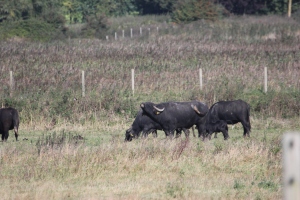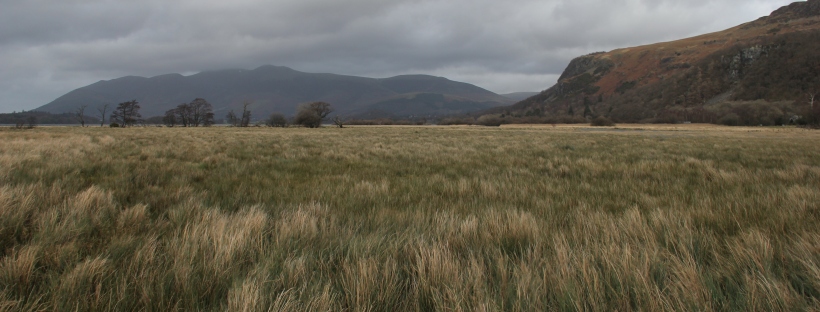Following on from this vague post, here are some vague ideas about rewilding, starting with…
>>A very brief natural history of Britain.
We’ll begin in the Palaeolithic; a cycle of glacials and interglacials, during which Britain was repeatedly colonised and evacuated by European plants, animals and people. As the climate warmed and the ice retreated for the final time (something like 15,000 years ago), humans recolonised Britain, initially via the huge estuarine landscape of Doggerland (now under the North Sea). As sea levels rose, the English channel cut Britain off from the rest of Europe, probably curtailing its colonisation by many animal and plant species.
It’s not totally clear how humans interacted with this post-glacial landscape. There would have been some hunting, some forest clearance, and some agriculture. Some species were hunted to extinction, others were assisted in colonising our island, and others still benefited from novel ecological niches provided by humans. Some probably went extinct ‘naturally’ as open-ish tundra gave way to more-or-less closed forest. The details aren’t important (well, not right now – convenient). I think the key point is that, since the ice sheets last wiped the slate clean, British wildlife has evolved, to a greater or lesser extent, alongside humans and a changing climate.
The result of this co-evolution has, I reckon, been an increase in ‘biodiversity’; both in terms of total species richness (due to the introduction of plants and animals from Europe and further afield) and spatial turnover from place-to-place (due to the maintenance of a mosaic of pre-successional habitats). In other words, a blanket of pristine Atlantic woodland would probably harbour fewer species (or at least fewer individuals of many species) than a patchwork of various natural and semi-natural habitats. (I haven’t given this much thought, but I think it’s probably a fair generalisation.)
Functional diversity, on the other hand, might well have been eroded (again, this is a hunch) due to the extirpation of several large-bodied, ecosystem-engineering, ‘keystone’ species (beaver, boar, aurochs, wolf). Many of the ecological functions once provided by these species – disturbance, grazing, predation, fear – are now provided partly or wholly by humans and their domesticated livestock. Unfortunately – at least away from a few nature reserves – this replacement of natural processes by anthropogenic ones has started to crumble as agricultural production across much of our countryside has (buzzword) intensified.

Moo
So, this is the context in which we find ourselves – or at least my interpretation. A transformed landscape within which ecological succession is interrupted by resource extraction and physical disturbance. A species inventory filtered, supplemented and moulded by a few millennia of co-evolution with humans. And an absence of many keystone species, leaving it up to humans to replicate extinct ecological processes. Importantly, a ‘pre-human’ baseline is hard to identify because we recolonised Britain at about the same time as many wildlife species, and during a period of climatic change.
>>Rewilding or ‘traditional’ management?
I think this leads on to one of the key conservation debates of the last few years; should conservationists attempt to actively mimic the traditional management practices which have replaced past ecological processes, or should we take a more hands-off approach (perhaps after kick-starting the system with a few species re-introductions) and let natural processes flourish?
Rewilding is exciting, and is catalysing a much-needed discussion. But, to my knowledge, evidence is pretty sparse when it comes to understanding what happens when humans step back. How will nature cope unaided in a landscape so fragmented and transformed as the British countryside? We’ve lost apex predators and mega-herbivores, and gained some pretty disruptive alien species; the climate has warmed, and the geochemistry has been tampered with. My gut feeling is that a ‘purist’ rewilding strategy – by definition relying on unimpeded natural processes – may result in some pretty negative biodiversity consequences, however we choose to measure these.
Most British rewilding projects might so far, I think, be better described as habitat recreation. Most rely on semi-feral domestic livestock, which are periodically controlled – humans stepping in to replicate the extinct process of predation (at whatever stocking density is decided upon by the reserve manager). I think for rewilding to work in its strictest sense, it needs to operate over larger areas, where nature can be left to its own devices.
Of course, this assumes a fairly strict definition of rewilding, and rather than getting hung up on semantics, maybe we should just get on with trying stuff out. ‘Rewilding’ is happening in Britain; these projects are reinvigorating and inspiring in their confrontation of the conservation status quo. In particular, I think the rewilding movement has a crucial role to play in:
- Encouraging process- rather than outcome-driven habitat management
- Thinking seriously about species re-introductions
- Thinking seriously about the ‘landscape scale’
- Reminding us of the past, even if a meaningful baseline is hard to grasp

Great piece Tom, and I agree with just about all of it!
A couple of observations:
I don’t think it’s a question or rewilding or ‘traditional’ management; rather, I think the question is, Does rewidling have a role in some places, alongside ‘traditional’ management in other places? A lot of the debate and heat appears to assume it’s one or the other.
The overwhelming majority of designated (terrestrial) wildlife sites in lowland England at least are fragments of ‘old farming’, and their features of interest assembled in response to traditional management. To my mind, it’s quite right that these should be subject to ‘traditional’ management that takes its cues from old farming systems, for now at least.
But, in other areas, different approaches might deliver high biodiversity values at low risk to existing values. Around me, and in some pastoral-dominated landscapes, there are large areas of farmland that were agriculturally improved and are still maintained as ‘farmland’ not because they yield anything, but because the subsidy regime incentives farmers to keep them open and under control. Some such places might be better set aside for carbon sequestration, water attenuation, recreation, new nature-based industries, under a rewilding regime.
I think an interesting question arises when we think about habitat creation targets: Habitat Action Plans very often contain targets to expand specific NVC plant communities – and quite often these NVC communities are ‘old farming’ assemblages (particular chalk grassland and lowland species-rich pasture communities for example). Given a choice, when we’re in a position to deliver some large-scale habitat creation, do we attempt to replicate ‘old farmland’ sorts of habitats, with all their attendant tight management prescriptions, or do we just set these areas aside, stick some ecosystem engineers in, and see what happens, with attendant close monitoring and research programmes?
You say that the context in which we find ourselves includes ”…..an absence of many keystone species, leaving it up to humans to replicate extinct ecological processes.” I think that, in the UK, we do need to have a debate about what role, if any, ecological surrogate species, and things back-bred to exhibit assumed ecological traits of globally-extinct species, might have. I’m not currently in favour of Pleistocene rewilding but am open minded about attempts to replicate recently lost species like the aurochs (I’ve written about this here: https://naturalareasblog.wordpress.com/2016/12/21/wild-cows/ ). In time, whether we like it or not, we’ll be presented with the option of using surrogates of extinct species rather than having to replicate extinct ecological processes ourselves. So, for example, if we have open habitat, we could replicate the defoliation process with a mower, use domestic stock to graze / browse, use back-bred bovids to do the grazing / browsing (and all the other process things wide-ranging wild-type bovids do….) or just step back and watch.
Hopefully all this rewilding debating will stimulate some high-quality experimental science.
Steve
LikeLiked by 1 person
But why not spend the huge amounts of money this needs on saving what is left of the genuine wild? It costs tens (if not hundreds) of thousands of pounds to do these sorts of thing in England, but meanwhile vast swathes of forest in south america (and elsewhere), can be saved at a couple of hundred dollars an acre, or less. In the Gran Chaco of Argentina, Bolivia and Paraguay around 1000 acres a day disappear under the bulldozers and chains, and with it all the fauna that lives there. All perfectly ‘legal’. Buying it is the only way to stop it. Check out World Land Trust website for more info.
John Burton
LikeLiked by 1 person
Yes, great point. The flip of which is that if we make UK farmland less intensive whilst converting chunks of it into new nature reserves, then we’ll increase the demand for imported food (unless we drastically cut waste and/or consumption) which will probably come from countries with much more biodiversity than our own.
LikeLiked by 1 person
A very good point. And precisely what is happening. Vast swathes are being deforested simply to provide animal feed and soya beans. Much of which ultimately ends up in the developed world. Nothing really has any impact unless we do something about human population — which needs to be not just stabilized, but drastically reduced, if everyone is going to aspire to the sort of standard of living, and resource consumption that the average Briton aspires to.
LikeLike
Tom- you asked elsewhere whether there was mapping showing the expected ‘natural’ vegetation community we’d expect across the UK. I have done these mapping in relation to wooded and non-wooded areas of Britain, and you link to these maps in this article:
http://www.self-willed-land.org.uk/articles/natural_veg_england.htm
LikeLike
John Burton of course is correct – cash spent on UK conservation could deliver far greater benefits for global conservation (in terms of averting extinctions of endemic and globally threatened species), if invested in the tropics instead. As a former staff member of the World Land Trust, and a member and contributor to appeals, I’d say WLT is the most effective UK-based international conservation organisation, and I would urge readers to donate to WLT in preference to any other international organisation, and any UK conservation project! BUT in the UK we ‘invest’ cash from general taxation into domestic wildlife conservation. I might be wrong, but I doubt realistically that those funds would be re-deployed to support overseas conservation. I’d like to see the £3.2 billion spent annually on farm support to be re-deployed in more sensible UK countryside support, both attempting to achieve wildlife-friendly farming (which we’ve failed to do so far) and an element of rewilding (in New Natural Areas, see: https://markavery.info/2017/08/23/32974/ ).
But, to repeat, please, readers, go to the World Land Trust web site and support their work:
http://www.worldlandtrust.org
Regarding what ‘natural’ vegetation we might expect in the UK, I think we need to be clear about the assumptions going into any such analyses. For starters, we need to be clear that we don’t know how decisive the influence of ecosystem engineers (e.g. wolves, lynx, aurochs, beavers) might have been in relation to the balance of closed canopy and open habitats. Many analyses either deny their existence or assume they were insignificant. I think we can only really work out how influential mixed communities of browsers and grazers were / would be through large-scale experiments. I think if our starting assumption is a half-empty landscape – lacking herbivorous mammals and their predators – then closed-canopy woodland is assured.
LikeLike